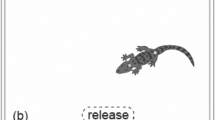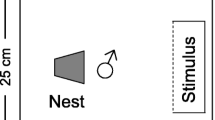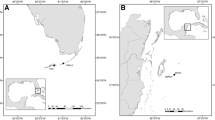Abstract
Mounting evidence indicates that learning shapes fish foraging and social behavior, which suggests that it may also underlie the frequently reported geographic variation in courtship. In this study, we analyzed how early social experience influences courtship patterns in males of the Amarillo fish (Girardinichthys multiradiatus). In a first experiment, we quantified the courtship of males from two allopatric populations grown in isolation and estimated the heritability of a key attribute of their courtship patterns. Then, we raised males from two allopatric populations with either sympatric or allopatric females and at two different densities, and registered their adult courtship patterns towards females from a third population. We found that the courtship pattern of males has a significant heritable component, yet in the second experiment, it was influenced by what type of females males were raised with, by their social rank (dominant/subordinate/singleton), and by the behavior of the female that they were courting. We conclude that courtship behavior in this fish has a congenital predisposition and is affected during development by different aspects of early experience and seemingly remains flexible throughout life; a complex ontogenetic trajectory that under natural conditions may have led to the locally stable dialect types observed in the courtship patterns of males from allopatric populations.
Similar content being viewed by others
References
Arnold C, Taborsky B (2010) Social experience in early ontogeny has lasting effects on social skills in cooperatively breeding cichlids. Anim Behav 79:621–630
Barbosa M, Ojanguren AF, Magurran AE (2013) Courtship display persists despite early social deprivation. Ethology 119:1–7
Bateson P (1983) Genes, environment and the development of behavior. In: Halliday TH, Slater PJB (eds) Animal behavior, vol 3, Genes, development and learning. Blackwell, Oxford, pp 52–81
Braaten RF, Reynolds K (1999) Auditory preference for conspecific song in isolation-reared zebra finches. Anim Behav 58:105–111
Chapman BB, Ward AJW, Krause J (2008) Schooling and learning: early social environment predicts social learning ability in the guppy Poecilia reticulata. Anim Behav 76:923–929
Chapman BB, Morell LJ, Krause J (2010) Unpredictability in food supply during early life influences boldness in fish. Behav Ecol 21:501–506
Clayton NS (1988) Song learning and mate choice in estrildid finches raised by two species. Anim Behav 36:1589–1600
Cook M, Mineka S, Wolkenstein B, Laitsch K (1985) Observational conditioning of snake fear in unrelated rhesus monkeys. J Abnorm Psychol 94:591–610
Dooling R, Searcy M (1980) Early perceptual selectivity in the swamp sparrow. Develop Psych 13:499–506
Eales LA (1985) Song learning in zebra finches: some effects of song model availability on what is learnt and when. Anim Behav 33:1293–1300
Evans JP, Kelley JL, Ramnarine IW, Pilastro A (2002) Female behavior mediates male courtship under predation risk in the guppy (Poecilia reticulata). Behav Ecol Sociobiol 52:496–502
Falconer DS (1960) Introduction to quantitative genetics. Ronald, New York
Farr JA (1980) Social behaviour patterns as determinants of reproductive success in the guppy, Poecilia reticulata Peters (Pisces: Poeciliidae): an experimental study of the effects of intermale competition, female choice, and sexual selection. Behaviour 74:38–91
Freeberg TM (2000) Culture and courtship in vertebrates: a review of social learning and transmission of courtship systems and mating patterns. Behav Process 51:177–192
Galef BG Jr, Laland KN (2005) Social learning in animals: empirical studies and theoretical models. Bioscience 55:489–499
Gerald JW (1971) Sound production during courtship in six species of sunfish (Centrarchidae). Evolution 25:75–87
González Zuarth C, Macías Garcia C (2006) Phenotypic differentiation and pre-mating isolation between allopatric populations of Girardinichthys multiradiatus. Proc R Soc Lond B 273:301–307
González-Zuarth CA, Vallarino A, Macías Garcia C (2011) Female responsiveness underlies the evolution of geographic variation in male courtship patterns between allopatric populations of the fish Girardinichthys multiradiatus. Evol Ecol 25:831–843
Guevara-Fiore P (2012) Early social experience significantly affects sexual behavior in male guppies. Anim Behav 84:191–195
Hagedorn M, Heiligenberg W (1985) Court and spark: electric signals in the courtship and mating of gymnotoid fish. Anim Behav 33:254–265
Hankison SJ, Morris MR (2003) Avoiding a compromise between sexual selection and species recognition: female swordtail fish assess multiple species-specific cues. Behav Ecol 14:282–287
Hultsch H (1991) Early experience can modify singing styles: evidence from experiments with nightingales, Luscinia megarhynchos. Anim Behav 42:883–889
Jordan LA, Brooks RC (2010) The lifetime costs of increased male reproductive effort: courtship, copulation and the Coolidge effect. J Evol Biol 23:2403–2409
Katsnelson E, Motro U, Feldman MW, Lotem A (2008) Early experience affects producer-scrounger foraging tendencies in the house sparrow. Anim Behav 75:1465–1472
Kelley JL, Macías Garcia C (2010) Ontogenetic effects of captive breeding. In: Breed MD, Moore J (eds) Encyclopedia of animal behavior 2. Academic, San Diego, pp 589–595
Kendrick KM, Hinton MR, Atkins K, Haupt MA, Skinner JD (1998) Mothers determine male sexual preferences. Nature 395:229–230
Kihslinger RL, Klimley AP (2002) Species identity and the temporal characteristics of fish acoustic signals. J Comp Psychol 116:210–214
Long KD, Rosenqvist G (1998) Changes in male guppy courting distance in response to a fluctuating light environment. Behav Ecol Sociobiol 44:77–83
Lynch M, Walsh B (1998) Genetics and analysis of quantitative traits. Sinauer Associates, New York
Maan ME, Seehausen O, Söderberg L, Johnson L, Ripmeester EAP, Mrosso HDJ, Taylor MI, van Dooren TJM, van Alphen JJM (2004) Intraspecific sexual selection on a speciation trait, male coloration, in the Lake Victoria cichlid Pundamilia nyererei. Proc R Soc Lond B 271:2445–2452
Macías Garcia C (1994) Social behavior and operational sex ratios in the viviparous fish Girardinichthys multiradiatus. Copeia 1994:919–925
Macías Garcia C, Jiménez G, Contreras B (1994) Correlational evidence of a sexually-selected handicap. Behav Ecol Sociobiol 35:253–259
Macías-Garcia C, Saborío E (2004) Sperm competition in a viviparous fish. Environ Biol Fish 70:211–217
Macías Garcia C, Saborío E, Berea C (1998) Does male-biased predation lead to male scarcity in a viviparous fish? J Fish Biol 53:104–117
Macías Garcia C, Smith G, González Zuarth C, Graves JA, Ritchie MG (2012) Variation in sexual dimorphism and assortative mating do not predict genetic divergence in the sexually dimorphic Goodeid fish Girardinichthys multiradiatus. Curr Zool 58:440–452
Macías-Garcia C, Valero A (2001) Context-dependent sexual mimicry in the viviparous fish Girardinichthys multiradiatus. Ethol Ecol Evol 13:331–339
Macías Garcia C, Valero A (2010) Sexual conflict and sexual selection in the Goodeinae, a clade of viviparous fish with effective female mate choice. Adv Stud Behav 42:1–54
Magnhagen C (1991) Predation risk as a cost of reproduction. Trends Ecol Evol 6:183–186
Magurran AE, Seghers BH (1990) Risk sensitive courtship in the guppy (Poecilia reticulata). Behaviour 112:194–201
Margulis SW, Nabong M, Alaks G, Walsh A, Lacy RC (2005) Effects of early experience on subsequent parental behavior and reproductive success in oldfield mice, Peromyscus polionotus. Anim Behav 69:627–634
Marler P, Peters S (1989) Species differences in auditory responsiveness in early vocal learning. In: Dooling RJ, Hulse SH (eds) The comparative psychology of audition: perceiving complex sounds. L. Erlbaum, Hillsdale, pp 243–273
Marler P, Tamura M (1962) Song ‘dialects’ in three populations of white-crowned sparrows. Condor 64:368–377
Martínez Medina L, Macías Garcia C, Flores Urbina A, Manjarres J, Moyaho A (2013) Female vibration discourages male courtship behaviour in the Amarillo fish (Girardinichthys multiradiatus). Behav Process 100:163–168
McGregor PK (1983) The response of corn buntings to playback of dialects. Z Tierpsychol 62:256–260
Miller JL, King AP, West MJ (2008) Female social networks influence male vocal development in brown-headed cowbirds, Molothrus ater. Anim Behav 76:931–941
Moore BR (2004) The evolution of learning. Biol Rev 79:301–335
Nelson DA, Marler P (1993) Innate recognition of song in white-crowned sparrows: a role in selective vocal learning? Anim Behav 46:806–808
Oetting S, Proeve E, Bischof H-J (1995) Sexual imprinting as a two-stage process: mechanisms of information storage and stabilization. Anim Behav 50:393–403
Payne RB, Payne LL, Woods JL (1998) Song learning in brood-parasitic indigo birds Vidua chalybeata: song mimicry of the host species. Anim Behav 55:1537–1553
Riebel K (2003) The ‘mute’ sex revisited: vocal production and perception learning in female songbirds. Adv Stud Behav 33:49–86
Ritchie MG, Hamill RM, Graves JA, Magurran AE, Webb SA, Macías Garcia C (2007) Sex and differentiation: population genetic divergence and sexual dimorphism in Mexican goodeid fish. J Evol Biol 20:2048–2055
Ryan MJ, Hews DK, Wagner WE Jr (1990) Sexual selection on alleles that determine body size in the swordtail Xiphophorus nigrensis. Behav Ecol Sociobiol 26:231–237
Shaw KA, Scotti ML, Foster SA (2007) Ancestral plasticity and the evolutionary diversification of courtship behaviour in threespine sticklebacks. Anim Behav 73:415–422
Sih A (1994) Predation risk and the evolutionary ecology of reproductive behavior. J Fish Biol 45:111–130
Slater PJB (1983) The study of communication. In: Haliday TR, Slater PJB (eds) Animal behaviour, vol 2. Blackwell Scientific Publications, Oxford, pp 9–42
Slater PJB, Clements FA, Goodfellow DG (1984) Local and regional variations in chaffinch song and the question of dialects. Behaviour 88:76–97
Stamps J (2003) Behavioral processes affecting development: Tinbergen’s fourth question comes to age. Anim Behav 66:1–13
Tinbergen N (1963) On aims and methods in ethology. Z Tierpsychol 20:410–433
ten Cate C, Vos DR (1999) Sexual imprinting and evolutionary processes in birds: a reassessment. Adv Stud Behav 28:1–31
Tramm NA, Servedio MR (2008) Evolution of mate-choice imprinting: competing strategies. Evolution 62:1991–2003
Valero A, Hudson R, Ávila Luna E, Macías Garcia C (2005) A cost worth paying: energetically expensive interactions with males protect females from intrasexual aggression. Behav Ecol Sociobiol 59:262–269
Verzijden MN, ten Cate C (2007) Early learning influences species assortative mating preferences in Lake Victoria cichlid fish. Biol Lett 2:134–136
Vos DR (1995) The role of sexual imprinting for sex recognition in zebra finches: a difference between males and females. Anim Behav 50:645–653
Vyas A, Harding C, Borg L, Bogdan D (2009) Acoustic characteristics, early experience, and endocrine status interact to modulate female zebra finches’ behavioral responses to song. Horm Behav 55:50–59
Webb SA, Graves JA, Macías-Garcia C, Magurran AE, Ó Foighil DO, Ritchie MG (2004) Molecular phylogeny of the livebearing Goodeidae (Cyprinodontiformes). Mol Phylogenet Evol 30:527–544
White DJ, King AP, West MJ (2002) Facultative development of courtship and communication in juvenile male cowbirds, Molothrus ater. Behav Ecol 13:487–496
Wilczynski W, Ryan MJ (1999) Geographic variation in animal communication systems. In: Foster SA, Endler JA (eds) Geographic variation in behavior: perspectives on evolutionary mechanisms. Oxford University Press, Oxford, pp 234–261
Wong BBM, Fisher HS, Rosenthal GG (2005) Species recognition by male swordtails via chemical cues. Behav Ecol 16:818–822
Zimmerer EJ, Kallman KD (1989) Genetic basis for alternative reproductive tactics in the pygmy swordtail, Xiphophorus nigrensis. Evolution 43:1298–1307
Acknowledgments
We thank S. Herce Castañón, E. Ávila, J. Aguirre, and P. Gesundheit for considerable help in the field; SEMARNAT for the fishing permission (01290/13); M. Méndez Janovitz for recording the fish behavior; and S. Herce Castañón and A. Ojeda Laguna for filming the fish. C. Berea de la Rosa collected the data on heritability, which was part of a larger project funded with CONACyT grant 1616-N9208 to CMG. We thank two anonymous referees and the Associate Editor for very valuable comments and criticism.
Ethical standards
In the design and conduct of the experiments, we followed the ethical guidelines for the use of animals in research published by ASAB/ABS. All the experiments complied with Mexican legislation.
Author information
Authors and Affiliations
Corresponding authors
Additional information
Communicated by A. Pilastro
Electronic supplementary material
Below is the link to the electronic supplementary material.
ESM 1
(PDF 92 kb)
Rights and permissions
About this article
Cite this article
De Gasperin, O., Macías Garcia, C. Congenital predispositions and early social experience determine the courtship patterns of males of the Amarillo fish. Behav Ecol Sociobiol 68, 639–648 (2014). https://doi.org/10.1007/s00265-013-1678-3
Received:
Revised:
Accepted:
Published:
Issue Date:
DOI: https://doi.org/10.1007/s00265-013-1678-3




